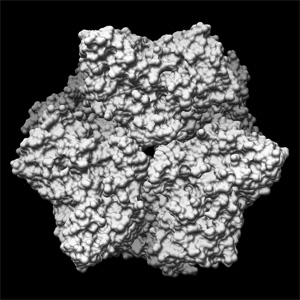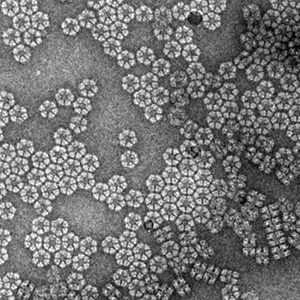Biology in 20 Minutes
|
Preface I gave this talk to my Honors Research Writing class at Walla Walla College in December 2003. Since only my figures and a hazy outline survive, the following is a reconstruction of that talk (with additions and improvements).
1. Introduction
2. Scientific Hierarchy
 Historically, we have been working both down this hierarchy from the top and up this hierarchy from the bottom. People have been describing and classifying plants and animals for thousands of years because all it requires is a pair of eyes. The invention of the light microscope brought the discovery of cells and the beginning of Cell Biology. The quest to see things on a smaller and smaller scale called for the invention of the electron microscope, which revealed the inner workings of cells down to the molecular level. People have also been playing with numbers and equations for thousands of years because it only requires ten fingers and a stick to write in the dirt. Only recently did people begin to use Mathematics as a background to describe physical phenomena. Sir Isaac Newton invented Calculus to describe the physics of moving objects. As Physics grew, atomic theory developed, which formed a nice basis for Chemistry. The focus of Chemistry is how atoms form molecules. This led to Molecular Biology, which focuses on DNA and Proteins - the large molecules found in living things. The theoretical progression up from Mathematics and the descriptive progression down from Classical Biology have met only recently, in the field of Molecular Biology. This is very exciting because you can form a theoretical model of a large molecule, and then see if your model is correct with an electron microscope. The scale of Biology is now complete - all the way from individual atoms to populations of organisms.
3. Two Types of Experiments: functional and correlative
Clearly fewer storks mean fewer babies. Many clinical studies fall into this category. For example, people that smoke have a higher risk for lung cancer. However, this does not prove that smoking causes lung cancer. Here's another example of a correlation: cars that have steering wheels can steer. However, this does not establish that the steering wheel causes the car to steer. Cars that can steer also have mirrors, so does that mean that mirrors are also needed for steering? Functional experiments are done to establish cause and effect relationships. For example, if you remove a car's steering wheel, you can no longer steer. A plant's need for light provides a more scientific example. For a loss of function experiment you could remove the light from the plant and it wouldn't grow. For a gain of function experiment, you could shine more light on the plant and it would grow more. Thus you may conclude that light causes a plant to grow.
4. Basic vs. Applied
5. Ultimate vs. Proximate Humanity's fondness for sugar provides a more scientific example. An ultimate explanation would be that the sugar present in ripe fruit was a signal to our ancestors that fruit was ready to eat. A proximate explanation would be that the sugar binds to taste receptors which stimulate a pleasure center in the brain. The Ultimate is often more interesting to ponder, but the Proximate is definitely easier to study.
6. Model Organisms You might not think we share much in common with yeast and wheat, but we do. All living things are made up of cells, and the machinery operating inside each cell is strikingly similar. Thus many important processes that occur in humans can be studied much more easily in other organisms. For example, all cells must fit about a meter of DNA into a space many times smaller than the period at the end of this sentence. This is accomplished in part by winding their DNA around proteins called histones. Shown below is a comparison of the amino acid* sequences of the H3 Histone from humans, wheat, and baker's yeast. Because their sequences are so similar, their structure and function are virtually identical.
Aside from the influence of our environment, our genes are what make us who we are. Your genes are what transformed a single fertilized egg into the 10 trillion cells of your body. Each of your genes is encoded in the DNA of each cell, similar to how recipes are recorded in a cookbook. Just as you would never make all of the recipes in a cookbook all at once, each cell in your body only expresses a certain set of genes at once. That is what makes the difference between a brain cell and a blood cell. When a cell expresses a gene, it first makes an RNA copy of the gene, perhaps like you would make a working photocopy of a recipe. Then the RNA recipe is read to make a protein. Proteins are the molecules that do most of the work in living things, from carrying oxygen in your blood to digesting your food.
 To figure out what a specific protein does, scientists usually try removing the gene that codes for it (a loss of function experiment). Then they infer what the protein does by studying what is wrong with the organism when the gene is missing.
8. Conclusion: Science is a way of looking The last few centuries have seen an incredible growth in our knowledge. The telescope allowed us to see the worlds beyond, and the microscope allowed us to see the worlds within. Some of the things we have seen have given us the power to heal and make life better (like medicine). Unfortunately, other things we have seen have given us the power to inflict pain and the loss of countless lives (like explosives). Science has made our lives safer and healthier, but it has also made our conflicts more deadly and horrific. That is a risk that scientists must take each time they look - they never know what they're going to see. Knowledge itself is neither good nor bad; it is we who make it so.
Acknowledgements |
| Created November 14, 2004; Completed January 2006; Revised July 2006 (Yes, I'm slow) |


